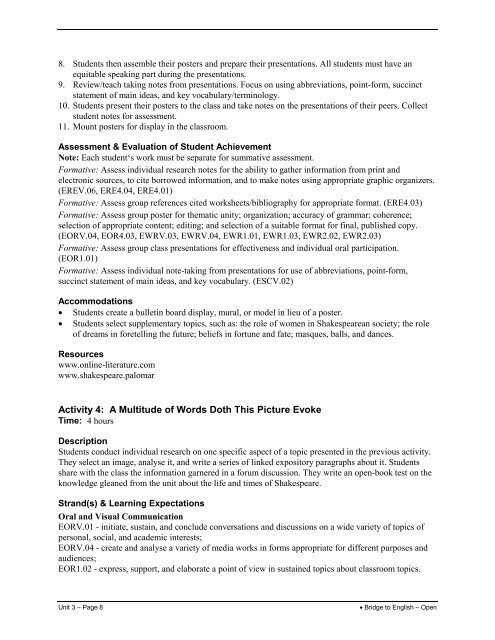Course Profile - Curriculum Services Canada
Course Profile - Curriculum Services Canada
Course Profile - Curriculum Services Canada
You also want an ePaper? Increase the reach of your titles
YUMPU automatically turns print PDFs into web optimized ePapers that Google loves.
8. Students then assemble their posters and prepare their presentations. All students must have an<br />
equitable speaking part during the presentations.<br />
9. Review/teach taking notes from presentations. Focus on using abbreviations, point-form, succinct<br />
statement of main ideas, and key vocabulary/terminology.<br />
10. Students present their posters to the class and take notes on the presentations of their peers. Collect<br />
student notes for assessment.<br />
11. Mount posters for display in the classroom.<br />
Assessment & Evaluation of Student Achievement<br />
Note: Each student‘s work must be separate for summative assessment.<br />
Formative: Assess individual research notes for the ability to gather information from print and<br />
electronic sources, to cite borrowed information, and to make notes using appropriate graphic organizers.<br />
(EREV.06, ERE4.04, ERE4.01)<br />
Formative: Assess group references cited worksheets/bibliography for appropriate format. (ERE4.03)<br />
Formative: Assess group poster for thematic unity; organization; accuracy of grammar; coherence;<br />
selection of appropriate content; editing; and selection of a suitable format for final, published copy.<br />
(EORV.04, EOR4.03, EWRV.03, EWRV.04, EWR1.01, EWR1.03, EWR2.02, EWR2.03)<br />
Formative: Assess group class presentations for effectiveness and individual oral participation.<br />
(EOR1.01)<br />
Formative: Assess individual note-taking from presentations for use of abbreviations, point-form,<br />
succinct statement of main ideas, and key vocabulary. (ESCV.02)<br />
Accommodations<br />
• Students create a bulletin board display, mural, or model in lieu of a poster.<br />
• Students select supplementary topics, such as: the role of women in Shakespearean society; the role<br />
of dreams in foretelling the future; beliefs in fortune and fate; masques, balls, and dances.<br />
Resources<br />
www.online-literature.com<br />
www.shakespeare.palomar<br />
Activity 4: A Multitude of Words Doth This Picture Evoke<br />
Time: 4 hours<br />
Description<br />
Students conduct individual research on one specific aspect of a topic presented in the previous activity.<br />
They select an image, analyse it, and write a series of linked expository paragraphs about it. Students<br />
share with the class the information garnered in a forum discussion. They write an open-book test on the<br />
knowledge gleaned from the unit about the life and times of Shakespeare.<br />
Strand(s) & Learning Expectations<br />
Oral and Visual Communication<br />
EORV.01 - initiate, sustain, and conclude conversations and discussions on a wide variety of topics of<br />
personal, social, and academic interests;<br />
EORV.04 - create and analyse a variety of media works in forms appropriate for different purposes and<br />
audiences;<br />
EOR1.02 - express, support, and elaborate a point of view in sustained topics about classroom topics.<br />
Unit 3 – Page 8<br />
• Bridge to English – Open

















